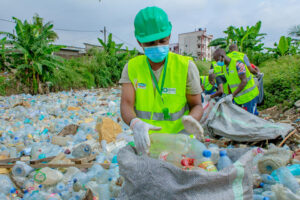No doubt! Plastic has become the most abundant man-made material that is found all around the globe. Yet, we rarely stop and wonder how this material is affecting our planet. Plastics contribute to the environmental pollution and numerous health risks associated with toxic exposure, warming temperatures, and extreme weather events due to climate change.

(picture courtesy: plastic waste management – Bing images)
Where do we stand regarding recycling of plastic?
Plastics are negatively affecting people and the environment at each stage of their lifecycle – extraction of fossil fuel, production, manufacturing, use, recycling, and disposal. The impacts are felt in a wide range of areas, including on biodiversity, climate change, human health, global economy, and human rights. Some of the adverse impacts are:
• Health impacts are being observed throughout the plastic value chain. This includes pollution at extraction sites, exposure to chemicals, air pollution from waste incineration, and water and soil contamination.
• Toxic additives added to plastic are released in the environment when exposed to various atmospheric conditions. These additives can be absorbed by the skin, evaporate into the air, or absorbed via the food or drinks we consume.
• Vulnerable and sensitive groups, including children and elders, workers in the informal waste sector and marginalized communities are particularly exposed to hazardous plastic pollution. Thus, raising concerns of human rights and environmental injustice.
• Synthetic fibres such as polyester, acrylic, rayon, and nylon are derived from petroleum and are a type of plastic. Microplastics are being constantly released into the air and water that we breathe in and drink every single day.
• Flora and fauna of various ecosystems and numerous terrestrial and marine species that contribute to Earth’s biodiversity are under pressure owing to climatic changes triggered due to plastic contamination and improper disposal. This situation is presenting a threat of extinction and endangerment of many rare and important species.
• Several infections, infestations, and contagious diseases are rampant and spread at a global level as plastic surfaces and microparticles harbour many insects and microorganisms.
What can we do to fight against excessive use of plastic?
We can follow many ways to keep plastic out of our environment! Listed below are some strategies we can adopt and share with our community:
• Reduce the use of plastic: It is unthinkable about all the plastic items we are using in our daily life. Can we even count and track all the plastic objects we use on day-to-day basis? Preparing ourselves with awareness regarding the way we ignorantly use plastic is a great starting point to reduce plastic waste.
• Habit of saying “No” to plastic: Habits are hard to change, but a small commitment even at an individual level can make a difference. Especially, in the case of single-use plastics which, according to data from the European Parliament, are responsible for 49% of all marine pollution.
• Promote and support the right laws and legislation: In addition to the essential change in individual behaviours and habits, it is important to support legislation that aims at reducing the use and production of plastic, improve recycling facilities and good management of waste.
• Encourage research and organizations: We must strictly follow and execute the environmental laws. One of the main weapons we can use to stop plastic pollution is research and development. Experimentation deepens our knowledge of the effects of the issue, so that, we can start implementing better policies to eradicate the challenges. Moreover, there are many NGOs and non-profit groups that rely on donations to develop their projects and research for reducing and eliminating plastic from the environment.
How do we handle the current plastic management crisis?
Let us commit and submit ourselves to some of the following new resolutions that can inspire and educate our fellow beings:
• Swap plastic bags for reusable and reliable bags made of cloth or fibre.
• Restrict the use of disposable plastic cups, plates, cutlery, and bottles. For example, carry personal beverage cups and water bottles to work places.
• Avoid useless plastic packaging and wrappings by buying food items and cleaning products in bulk and in an organised manner. Nowadays, there are plenty of options to choose from, and many supermarkets let us fill our own jars/bags.
• Choose metal or glass food containers and storage options instead of plastic boxes.
• Avoid buying and using cosmetics that contain plastic microspheres or microbeads.
• Reduce the use of clothing and accessories made of synthetic materials.
• Organise and participate in social awareness and locality clean up camps as frequently as possible. For instance, people who live by a sea or river, can volunteer to pick up litter in their local community.
• Join in one or more of the non-profit organizations along with your friends and family members to promote environment-friendly vibes and spread smiles to future generations.
Ultimately, our goal must be to remove plastics from our surroundings and prevent plastic pollutants to enter our ecosystems in the first place. Every little step helps us achieve a huge change towards a bright future!
